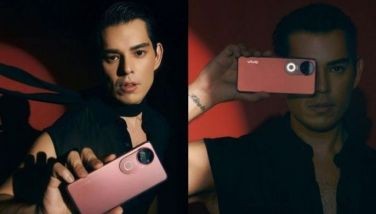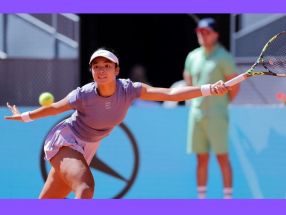The Callaway way: Sports is science
January 16, 2007 | 12:00am
I have often stated that sport is science. This simply means that science and technology play important roles in preparing the human being to excel in sports, from talent identification, to nutrition and to sports psychology, and in providing the athlete with the training and competition gear to excel and the occasional player to enjoy the game to the fullest.
A great number of sports are dependent on science and technology in helping athletes to go "higher, faster and stronger." Golf is one such sport.
Over the years, golf has been so revolutionized that golf clubs have become so user friendly that it takes comparatively less effort to hit that be-dimpled ball straighter and, sometimes, longer.
Callaway golf clubs easily stand out as one of the prime examples of the use of science and technology to get the best out of players who are able to accomplish what seemed impossible some time back.
Its founder, Ely Reeves Callaway Jr. who passed away in 2001, said "Callaway Golf has always believed that the way to grow the game of golf is to make it more enjoyable for the average golfer. That is why (Callaway) tries to design, create, build and sell the most forgiving clubs in the history of the game — giving more golfers more opportunities to hit a few additional great shots each round. (Callaway) intends to continue to grow the game by helping people enjoy the game."
Its latest driver that promises to be the friendliest and most forgiving clubs is the FTi that will come out in the country February 2007. The FTi has a square club head that allows redistribution of the club head’s weight to both its sides. According to Antonio (Tony) Herrera Jr., head of Electrobus, exclusive Callaway distributor in the Philippines, all Callaway follows the principle of the S2H2 technology which means short, straight, hollow and hosel (where the tip of the shaft and club head meet).
Glenn Baroma, marketing executive of Electrobus emphasizes that only Callaway has the bore through design. Its distinct advantage is its repositioning of the club weight along the head’s perimeter thus creating a bigger and lower "sweet spot" area. For golfers, the sweet spot is that part of the club head that should come squarely in contact with the ball to produce a straighter and more solid shot. Callaway does not claim that its clubs are the longest hitting but rather the most forgiving and friendliest club.
Herrera and Baroma, who are both graduates of electrical engineering from the University of the Philippines (UP) and were classmates at elementary and secondary at the UP, claim that physics is the field of science that bore heavily on Callaway golf clubs.
Both Herrera and Baroma, who are 51 years old, state that the FTi design prevents or minimizes twisting of the club so that the golfer is able to hit the ball squarely upon impact. The driver is United States Golf Association compliant and is used by some of the top professionals in the US Tour like Phil Mickelson and Annika Sorenstam. Local endorsers of Callaway clubs are Angelo Que, Roger Antonio and Carito Villaroman.
The technology orientation of Callaway was the key factor that led Tony Jr.’s father, Antonio Sr., to inform Callaway USA of Electrobus’s desire to represent the Carlsbad, California-based company in the Philippines in 1990. Antonio Sr. had seen an ad in the Golf Digest that had Callaway advocating the use of Isaac Newton’s studies in physics to produce user friendly clubs.
Antonio Sr., also an electrical engineer, called up Callaway which, in 1990, was only eight years old. In 1984, Ely Callaway had bought Hickory Stick which became Callaway. In 1991, Callaway launched the Big Bertha, the driver that caught the golfing world by storm and which set the pattern for future golf club research and development. The flagship driver which was named after the World War I cannon, was followed by, among others, the Great Big Bertha, ERC (I, II, III), Hawkeye and Steelhead.
By 2005, Callaway had gross sales of $998.1 million, up by 6.8 percent from 2004, and a net income of $13.3 million. These sales figures come from the sale of drivers, fairway woods, irons, wedges, Odyssey White Hot and Dual Force putters and high-tech golf balls (HX, HX Tour, Big Bertha). In late 2003, Callaway purchased Top-Flite, Strata and Ben Hogan brands from the bankrupt Top-Flite golf company.
Since Electrobus’s appointment in 1990, Callaway accounts for about one third of the estimated annual Philippine market of P200 million. In some years, Callaway’s share would go as high as 50 percent. A lot of the credit for this outstanding performance goes to the hardworking techno entrepreneurs, Herrera and Baroma, who supervise the operations of five company-owned outlets in Shangri-la Plaza, Panay Avenue in Quezon City; Mall of Asia and Rustan’s Makati and Alabang.
A great number of sports are dependent on science and technology in helping athletes to go "higher, faster and stronger." Golf is one such sport.
Over the years, golf has been so revolutionized that golf clubs have become so user friendly that it takes comparatively less effort to hit that be-dimpled ball straighter and, sometimes, longer.
Callaway golf clubs easily stand out as one of the prime examples of the use of science and technology to get the best out of players who are able to accomplish what seemed impossible some time back.
Its founder, Ely Reeves Callaway Jr. who passed away in 2001, said "Callaway Golf has always believed that the way to grow the game of golf is to make it more enjoyable for the average golfer. That is why (Callaway) tries to design, create, build and sell the most forgiving clubs in the history of the game — giving more golfers more opportunities to hit a few additional great shots each round. (Callaway) intends to continue to grow the game by helping people enjoy the game."
Its latest driver that promises to be the friendliest and most forgiving clubs is the FTi that will come out in the country February 2007. The FTi has a square club head that allows redistribution of the club head’s weight to both its sides. According to Antonio (Tony) Herrera Jr., head of Electrobus, exclusive Callaway distributor in the Philippines, all Callaway follows the principle of the S2H2 technology which means short, straight, hollow and hosel (where the tip of the shaft and club head meet).
Glenn Baroma, marketing executive of Electrobus emphasizes that only Callaway has the bore through design. Its distinct advantage is its repositioning of the club weight along the head’s perimeter thus creating a bigger and lower "sweet spot" area. For golfers, the sweet spot is that part of the club head that should come squarely in contact with the ball to produce a straighter and more solid shot. Callaway does not claim that its clubs are the longest hitting but rather the most forgiving and friendliest club.
Herrera and Baroma, who are both graduates of electrical engineering from the University of the Philippines (UP) and were classmates at elementary and secondary at the UP, claim that physics is the field of science that bore heavily on Callaway golf clubs.
Both Herrera and Baroma, who are 51 years old, state that the FTi design prevents or minimizes twisting of the club so that the golfer is able to hit the ball squarely upon impact. The driver is United States Golf Association compliant and is used by some of the top professionals in the US Tour like Phil Mickelson and Annika Sorenstam. Local endorsers of Callaway clubs are Angelo Que, Roger Antonio and Carito Villaroman.
The technology orientation of Callaway was the key factor that led Tony Jr.’s father, Antonio Sr., to inform Callaway USA of Electrobus’s desire to represent the Carlsbad, California-based company in the Philippines in 1990. Antonio Sr. had seen an ad in the Golf Digest that had Callaway advocating the use of Isaac Newton’s studies in physics to produce user friendly clubs.
Antonio Sr., also an electrical engineer, called up Callaway which, in 1990, was only eight years old. In 1984, Ely Callaway had bought Hickory Stick which became Callaway. In 1991, Callaway launched the Big Bertha, the driver that caught the golfing world by storm and which set the pattern for future golf club research and development. The flagship driver which was named after the World War I cannon, was followed by, among others, the Great Big Bertha, ERC (I, II, III), Hawkeye and Steelhead.
By 2005, Callaway had gross sales of $998.1 million, up by 6.8 percent from 2004, and a net income of $13.3 million. These sales figures come from the sale of drivers, fairway woods, irons, wedges, Odyssey White Hot and Dual Force putters and high-tech golf balls (HX, HX Tour, Big Bertha). In late 2003, Callaway purchased Top-Flite, Strata and Ben Hogan brands from the bankrupt Top-Flite golf company.
Since Electrobus’s appointment in 1990, Callaway accounts for about one third of the estimated annual Philippine market of P200 million. In some years, Callaway’s share would go as high as 50 percent. A lot of the credit for this outstanding performance goes to the hardworking techno entrepreneurs, Herrera and Baroma, who supervise the operations of five company-owned outlets in Shangri-la Plaza, Panay Avenue in Quezon City; Mall of Asia and Rustan’s Makati and Alabang.
BrandSpace Articles
<
>
- Latest
- Trending
Trending
Latest
Trending
Latest
Recommended





























